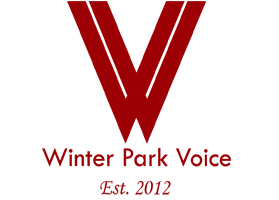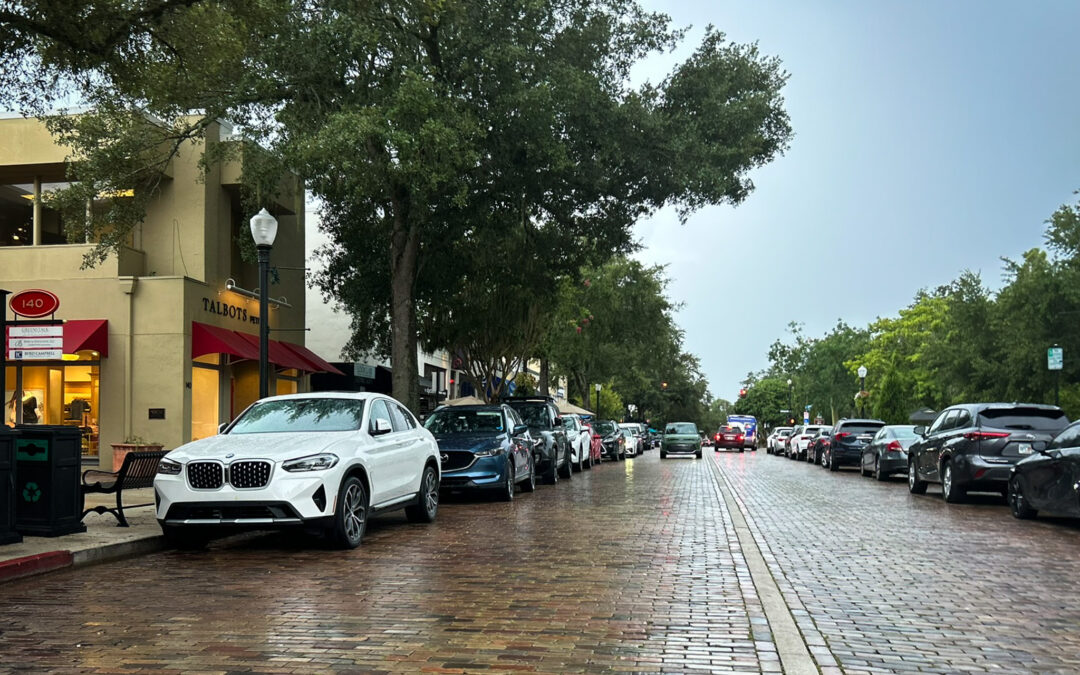Developers could catch a break on parking rules if changes approved
The P&Z board will tonight hold the first hearing on changes designed to avoid large, mostly empty lots
Sept. 3, 2024
By Beth Kassab
Developers could soon face less strict parking requirements in Winter Park if recommended changes are approved to reduce the number of spaces required for shops, offices and apartments.
The Planning & Zoning Board will hear the proposal for the first time on Tuesday night at 6 p.m.
Last year the Winter Park Chamber of Commerce brought in the author of “Paved Paradise: How Parking Explains the World” to advocate for loosening the number of required spaces for new development.
Henry Grabar argues that all over America, cities are underhoused and overparked. Valuable real estate is taken up by too many unused parking spaces. And that, he says, drives up the cost of construction and pushes sprawl.
Onerous parking codes also offer a way for residents to oppose new affordable or denser housing projects.
“Badmouthing the poor was a little unseemly,” he wrote. “But complaining about parking was morally unimpeachable.”
In fact, parking became a focus in the recent debate over Rollins’ proposal to build 30 units that it plans to rent below market rate to its faculty and staff. The City Commission approved the project last week, ultimately, with a compromised parking arrangement and a pledge from Rollins to give over some land for more on-street parking.
The parking standards used in that project are aligned with the proposed changes from city staff.
Among the proposed changes outlined in the memorandum:
- Unify the parking code requirement for non-medical office and retail city-wide to one space per 333 square feet versus the current rule of one space per 250 square feet. According to the staff report, the standard is already one space for 333 square feet in the Central Business District, the Hannibal Square neighborhood and the Orange Avenue Overlay. This is a 25% decrease in parking required for retail or non-medical office.
- Reduce parking at large office buildings, which have the largest parking surpluses, according to the report. Combined with the change above this would further reduce the parking requirements to one space per 400 square feet for any building larger than 15,000 square feet. “For example, a 30,000 square foot office building now needs 120 parking spaces,” the staff report explained. “With the two changes together (1 per 333 for the first 15,000 square feet and 1 per 400 for next 15,000 square feet), the parking required is 83 spaces. This is a 30% reduction in required parking.”
- For apartments of three or more units, the standards would be 1.25 spaces for a one-bedroom unit; 2 spaces for a two-bedroom unit and 2.5 spaces for a three-bedroom unit. This is the same standard that exists now for properties within the Orange Avenue Overlay. For townhouse and condo projects with larger units, the current rule would remain of 2.5 spaces if the unit is larger than 2,000 square feet.
- The maximum parking provision could be no more than 150% of the code requirement.
During the discussion about the Rollins faculty apartments, some commissioners indicated they may not be on board with the changes.
Commissioner Todd Weaver, who voted against the project, said he would “never vote for decreasing parking in our downtown because there’s no mass transit.”
That has been a key criticism of Grabar’s philosophy — that not every city has the local buses, shuttles or other options in place to wean residents off of their dependence on cars.
Winter Park boasts one of the most successful SunRail stops on the commuter rail’s line, but rail system along with the Lynx bus system lack a regional dedicated funding source to keep up with demand.
The city staff report, however, argues there are reasons unrelated to the transportation debate to reduce parking requirements, especially among office buildings.
“Office floor plans have evolved over the years with larger offices, fewer open-air cubicles and more amenity space,” the report said. “Additionally, the nature of most office businesses has changed so that fewer clients need to visit with the use of email and electronic communication. It also is prudent to have a unified city-wide parking rate for office and retail versus different geographic parking rates, thus the proposal for one per 333 square feet city-wide.”
WinterParkVoiceEditor@gmail.com


And yet the city wants to add approx. 70 parking spaces to the Library and events center. Taking away more green space from MLK park. Even after the city reached a parking deal with the business next store. And don’t forget the chamber of commerce has signs out side of their offices that clearly state “Chamber of Commerce Parking Only”. So even they recognize there is not enough parking to go around.
Winter Park is not “all over America,” and its parking issues need to be addressed by focusing on its own parking conditions. A look at currrent problems, created in recent years points to an increase rather than a decline in parking difficulties. Examples: parking for the commercial venues across from the Library is short of parking, resulting in many of customers using the Library lot. Nearby Trader Joe’s is also drastically short of parking. Elsewhere, cars parked all over the streets around the new Alfond hotel on New England, it looks as if the parking there is also inadquate. On Interlaachen, across from the Cloisters, a recently constructed condo has underground parking for residents, but no space avove for visitors or service vehicles. The latter often park (illegally) on the street, blocking traffic. The Cloisters has ample parking situation, which, I’ve been told, sometimes leads to vehicles with business across the street ending up on Cloister’s parking.
Claims about office employees working at home or Sunrail alleviating parking problems have not shown to have eased parking needs in Winter Park. Instead, the inadequate parking in the city suggests that more parking for multi-family residences, office and commercial properties should be required.
Reduced parking requirements for non-medical offices seems appropriate today. The parking garage on Canton Ave. behind Panera’s always has many empty spaces reserved to meet office requirements. Perhaps some of those could be converted to public parking.
The occupancy requirements and proposed use for a building should align with its parking requirements. If a 30,000 sq ft office building is allowed to have 250+ workers in it at a time, then 83 parking spaces doesn’t make much sense. It is highly unlikely that enough sustainable carpools could be arranged among those 250 workers to squeeze them into <83 vehicles. Public transit options in this area are far too limited to rationally propose that is an alternative. If anyone is concerned about paving over paradise to put up a parking lot, perhaps WP should challenge the assumption that developers need to pave anything at all, and start buying up land for parks instead of catering to greedy developers.
What a dumb idea. Did Mr. Grabar need to find a spot at Trader Joe’s or Guidewell Clinic when he was here? Did he try to parallel park along Park Avenue when two cars take up 3 spaces? We already have issues with finding a parking space at numerous WP businesses doing this will make it even worse. The idea of giving 1.25 spaces for a 1 bedroom unit, 2 spaces for a 2-bedroom unit and 2.5 for a 3 bedroom is ridiculous. With soaring rents, what if there are 2 people living in a 1 bedroom or 3 people are renting a 3 bedroom and they all have cars? A .25 parking space isn’t going to help any of them. Because we all know if you don’t have a car around here, you’re SOL. Where are they going to park? I mean why not just give developers everything they ever ask for and not worry about the public? Developers who whine the loudest win. Seems really short-sighted, asinine and will cause more problems than we already have. No thank you.
I’d also like to ask where are these large, mostly empty lots? I would love to know because maybe I could park there! I am all for more dense housing but parking will always be an issue when we have no viable mass transportation.
The “Paved Paradise” author reminds me of two things. (1) A college statistics professor who said, ‘You can make the numbers say anything you want” and (2) Dueling “expert witnesses” at a criminal trial.
Actually, there’s a third thing: If it looks like a duck, swims like a duck, and quacks like a duck …”
It doesn’t require extensive parking studies to reveal what is all-too-obvious to any resident or visitor. We need MORE parking in our ordinances, NOT LESS. Reducing parking requirements for developers is foolish.
First: what’s the rush?
Second: the case for developer “crisis” has hardly been made.
Third: what’s wrong with being on the back end of a national trend (if it even exists, as the Chamber implies)
Fourth: it’s Chamber proposed (and this is a Chamber with a political PAC often contrary to this city council direction)
Fifth: consider parking/developer requests on a case-by-case basis. It’s always context—usage, neighboring properties, restaurant, retail, office, noise and lighting issues, after biz hours shared objectives.
Sixth: this is a hyped solution looking for a problem. I say “just park it(!)
Wondering exactly how many emails and calls from WP residents (excluding developers) asking for reduced parking requirements anywhere in the city have been received by the city commission, city manager or staff over the past 5 years. My guess is zero or close to it. How an idea like this not only arises but is advanced against the average citizen’s interest is perplexing … in a concerning way. Ask the average resident if too much parking is available to them… near the Alfond, the Woman’s Club, near All Saints, on Park Avenue, at City Hall, at the new Library, at Trader Joe’s, WP Village, or even in the Canton garage and you will hear a resounding no. When will the commission learn to rebuff, rather than advance, these bad ideas that serve developers…over rank and file residents? This idea did not come from vast numbers of ordinary residents, it came from developers. Just like @ Trader Joe’s. The OAO parking modification. The Rollins request to build 30 apartments. The Alfond. The former Orchard Supply on 17-92. The Ollie garage was supposed to be a parking savior. It wasn’t. And it holds hundreds and hundreds of cars. The same great minds are bringing us this parking reduction idea.
Wow, you all said it all! Great observations. Here is mine I borrowed from a book. I would follow Duany, Plater-Zyberk, & Speck in their Suburban Nation-“But it is important to remember that where is more significant than how much, and that the quality of the street space comes first” (p. 208).
I don’t even try to go to any Park Avenue establishments because of the difficulty finding parking. Just to attend a daytime meeting at City Hall takes multiple trips through the City Hall parking lot and around the nearby blocks.
Downtown WP parking is a nightmare. Who hasn’t felt like a shark circling around the block hoping someone leaves before you finally give up? The only people who don’t think parking is a problem in downtown WP either own a property or work somewhere with designated parking they can use. The city could easily run a trolley service between the various city lots, the private garages, and a few peripheral shopping areas. Designated “stops” could be made in all the shopping and dining areas. Think Anna Maria Island. This isn’t rocket science. I’d be willing to bet a greater amount of CO2 greenhouse good would be done by a trolly eliminating the parking shark hunts than the few electric car charging stations. Let’s get a trolley on the schedule please, Commissioners.